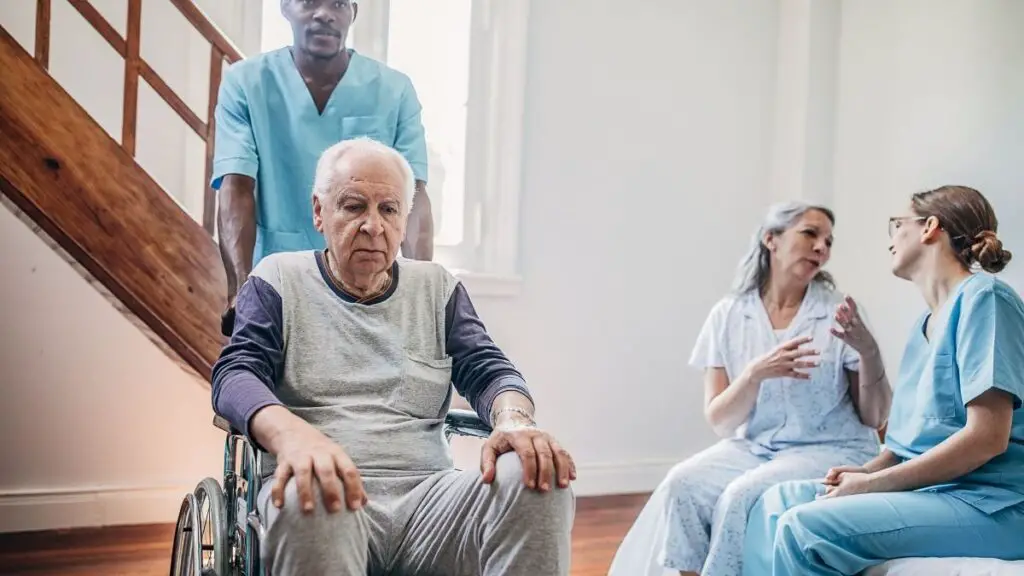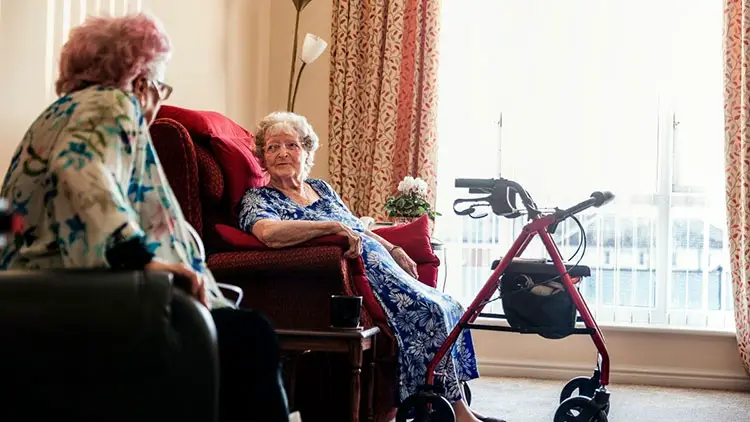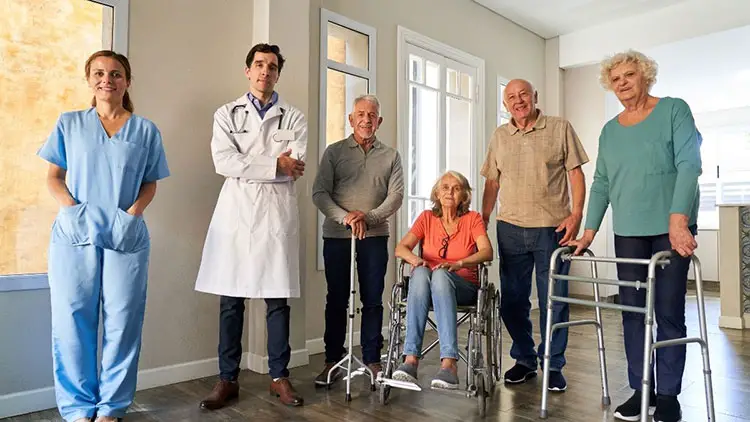Key Points:
- “Old folks home” is a catchall phrase to describe different types of housing facilities where seniors reside.
- Senior housing can be broken into 4 different categories: multi-residence housing, congregate housing, assisted living, and nursing facilities.
When you think about possible places for your mom, dad and grandparents to live, do you ever use the term “old folks’ home”? If so, simply say to yourself, “Oops!” and start using the appropriate phrases to replace it.
In the ‘old days’ of the 1970s to 1990s, the term “old folks’ home” was popular and appropriate. That was a time period where there weren’t a lot of options for senior citizens. When someone was over the age of 55 and their health began declining, they might be taken to an old folks’ home, which in most cases is a nursing home by today’s classification.
They ended up living the rest of their life there. During this time frame, the only places where someone could go were a few retirement communities or sometimes hospice if someone had an incurable condition.
The term “old folks’ home” is now considered a general phrase with no specific designation. It’s a catchall phrase that means nothing and says nothing about the location you are referring to. And now it’s less politically correct than it may have been once upon a time. Few people with more years under them want to be referred to as an “old folk.” Many people now prefer the more respectful words “elder” or “older adult.”
It’s almost an insult to say someone is in the old folks’ home… it’s discriminatory, implying that the old folks are a part of society that you may not want to be associated with. It’s denigrating in a way as well, implying that when someone gets to an older age, they need to be put away. And that’s why so many senior citizens are totally offended if you mention the words. Be careful with the words you use and instead, adopt a more precise set of words to describe the “old folks’ home” you’re referencing.
4 Different Types of Old Folks Homes
If you look at these types of residences from the standpoint of what type of building structure they are, you will find four primary types, listed below. Each of them may include more than one of the types mentioned above.
1) Multi-Residence Housing
This is a building that houses multiple unrelated people. The building could be independent living apartments, which are great for senior citizens that have similar interests. Generally speaking, this type of housing is for those who are not dependent on others for their care. Their health status is also pretty good and they do not need a lot of medical care.
2) Congregate Housing
Congregate housing is a lot like independent living but the big difference is that meals, transportation and housekeeping are included. It’s federally-subsidized housing that is project-based, not tenant-based. The States receive grants from the Congregate Housing Services Program to provide services for elderly who are frail and those who have disabilities. The program usually includes delivery of 1 meal a day in a group setting 7 days a week and nonmedical support services. Program participants pay a minimum of 10% of the program costs, up to 20% of the person’s adjusted income.
3) Assisted Living
These are places that have personal care services, offer meals, assist with bathing, laundry and housekeeping. If you are fully functional and mobile, you would not choose an assisted living home or type of housing.
4) Nursing Facilities
Nursing homes are facilities that hire trained nurses, doctors, dietitians, and physical therapists for specialized care to senior citizens. Nursing staff are on duty 24/7 and assist those who have several or severe illnesses or injuries. The residents are unable to live independently and need help with activities of daily living such as eating, bathing, laundry and housekeeping. Nursing facilities may be short-term or long-term. They may be utilized for acute care and may be intermediate care.
Other Examples of an ‘Old Folks Home’
The options that seniors have to live are many. Each of them has its own definition, cost, advantages and disadvantages. If you are considering the options for a place to live for yourself or your loved ones, ask these questions:
- Is it for those who are independent or those that need care?
- Is the type of housing licensed or not, and if so, by whom?
- Are medical staff on premises 24/7 and is this necessary for me?
- Who safeguards that the housing is safe?
- Are there nurses on staff that can give medications and take care of bathing, meals, grooming, dressing and toileting?
- Does the staff include any rehab staff, physical therapy, memory care, or other services that are needed?
- Can I afford the cost?
- Does this option offer me only housing or something a lot more that can impact my quality of life?
Some of the many terms that have officially replaced “old folks’ home” include the previously mentioned four categories, but there are subcategories of those, or other services that may not qualify fully as a home, but include elder care. Adult day care is an example. I directed an adult day care center for people with Alzheimer’s for a few years. This was a day program attached to an assisted living facility.
Here are other long-term care type services that serve seniors. Some of these are relatively new. All of these, back in the day, probably would have been referred to as an “old folks home.”
1) Adult Homes
If you are unable to live independently, you may choose to live in a licensed adult home for either a short or long period of time. These homes offer three meals a day, supervision, personal care, and housekeeping.
2) Adult Day Care
This option is not for overnight stays and really not for housing, but it’s a term that should be understood. An adult day care operates as a regular day care but not for those who are young. It opens in the morning and closes in the evening in much the same way as the more well-known child care services. Seniors who have challenges with physical disabilities or emotional disabilities are given rehab, social interactions and activities, and have access to health-related services at the facility.
3) Independent Living Apartments
This option is for those who can move about freely and are not in need of medical care. It’s for those who want to be around other seniors to go places together and participate in projects on-premise. The seniors live independently here, doing what they want, coming and going as they please. These apartments are like regular apartments in the community; not licensed or regulated.
4) The Eden Alternative
Eden Alternative is a nursing home that has created a habitat for humans, not one for the frail and elderly. Structurally it doesn’t look like an old time nursing home and includes gardens, courtyards and outdoor access. Person-directed care is the goal, and the facilities offer vibrant, life-affirming environments, places where each person matters and everyone can grow, young or old.
The Eden Alternative is a nonprofit that started the whole move to person-directed care for senior citizens. Caregivers and seniors both are called “care partners” because they each give and receive. Enhanced well-being is a major goal as is the elimination of helplessness, boredom and loneliness, common problems amongst those who are older. Well-being is defined here by Dr. Bill Thomas, founder of the organization:
Well-being is the path to a life worth living. It is the ultimate outcome of a human life. Through a grant-funded collaborative effort, The Eden Alternative brought together a task force of culture change experts in 2004 and identified the seven Eden Alternative Domains of Well-Being®. Together, they serve as a simple framework for asking thoughtful questions that help identify the unmet needs of those we care for.
Dr. Bill Thomas
| IDENTITY | being well-known; having personhood; individuality; having a history |
| GROWTH | development; enrichment; expanding; evolving |
| AUTONOMY | liberty; self-determination; choice; freedom |
| SECURITY | freedom from doubt, anxiety, or fear; safety; privacy; dignity; respect |
| CONNECTEDNESS | belonging; engaged; involved; connected to time, place, and nature |
| MEANING | significance; heart; hope; value; purpose; sacredness |
| JOY | happiness; pleasure; delight; contentment; enjoyment |
5) The Green House Project
The goal for the Green House Project is to provide senior citizens with a non-institutionalized environment for their care via residential homes with 6-10 seniors. The homes have been converted to provide high levels of care. The idea is to keep the senior out of a nursing home. The environment is furnished and decorated for comfort and warmth. Smart technology of computers, ceiling lifts and adaptive devices are utilized. Plenty of sunlight, gardens, courtyards, and outdoor access are one of the defining characteristics of these homes.
6) Family-Type Homes
This option is where up to four adults who are unrelated live together and are supervised. Their residential care and housekeeping are included in the costs. This type of housing is often overseen by the various states’ Departments of Social Services (or equivalent).
7) Enriched Housing
These are independent housing units that you live in. One meal per day is included and this type of housing must be licensed by that state’s Department of Health (or equivalent).
8) Memory Care Facilities / Alzheimer’s Care Facilities
This is 24-hour housing for those with dementia or Alzheimer’s disease. The environment is designed for safety, specialized memory care staff that focus on therapy to enhance memory, and cover medication administration, transportation, toileting, laundry, housekeeping, meals, personal care, and mobility assistance. The layouts of the facility are designed to reduce confusion but still offer enclosed courtyards or gardens so seniors can spend time outdoors in a safe way.
Some of the therapies available may include pet therapy, art therapy, music therapy, and occupational therapy. One of the latest types of therapy is called reminiscence therapy, where therapists use the five senses to help stimulate memories. You will not find the specific types of memory improvement therapies in other types of homes. Cost is between $3,000 and 9,000 a month but there may be extra costs for medical care or personal services (source).
9) Aging in Place / Continuing Care Retirement Communities
These are also called lifecare communities. There will be several different types of facilities on the ‘campus’, including assisted living to nursing homes. The advantage of this option is that if you need a higher level of care or a lower level of care, the transition is easier because you know the surroundings. Going from one level of care to another is called ‘aging in place’.
To become part of this type of community, you may have to buy into it or purchase an annuity upfront. Whichever way, you will still have monthly payments for any medical care, amenities or services needed. The advantage of this option is that you can stay in your own home no matter what happens to you physically or mentally, i.e., if your condition worsens.
Each one of these terms is much more specific than the old folks home term. The new terms are also kinder. We’ll explain these later in the article.
Benefits of Volunteering at an Old Folks Home
These 14 benefits of volunteering to do things with and for seniors are just the tip of the iceberg when it comes to the good things that come of this type of activity. Take a look:
- Your efforts reduce loneliness and your smile brings happiness.
- You will feel like you have a purpose.
- Your self-esteem will increase.
- You feel socially connected.
- In listening to seniors tell their stories, you value them and their lives.
- You may learn some new skills or perfect social skills.
- You have new friends, almost instantly.
- You can bring your dog.
- It’s a good place to give out hugs.
- You never know what you will learn from a senior – maybe important life lessons.
- You can donate your crafts to help out the seniors.
- You’ll hear stories that will make you evaluate which direction your life is going, and make appropriate changes.
- You can overcome your own depression by giving to others.
- You will learn how to get along better with senior citizens, and how they think.
We’ve written an entire article on the benefits of volunteering at a nursing home, but some volunteers may find lower level housing a better fit, where residents have more of their faculties and abilities still intact. This is a decision each volunteer makes, but regardless of what long-term care facility one volunteers at, the rewards are the same.





